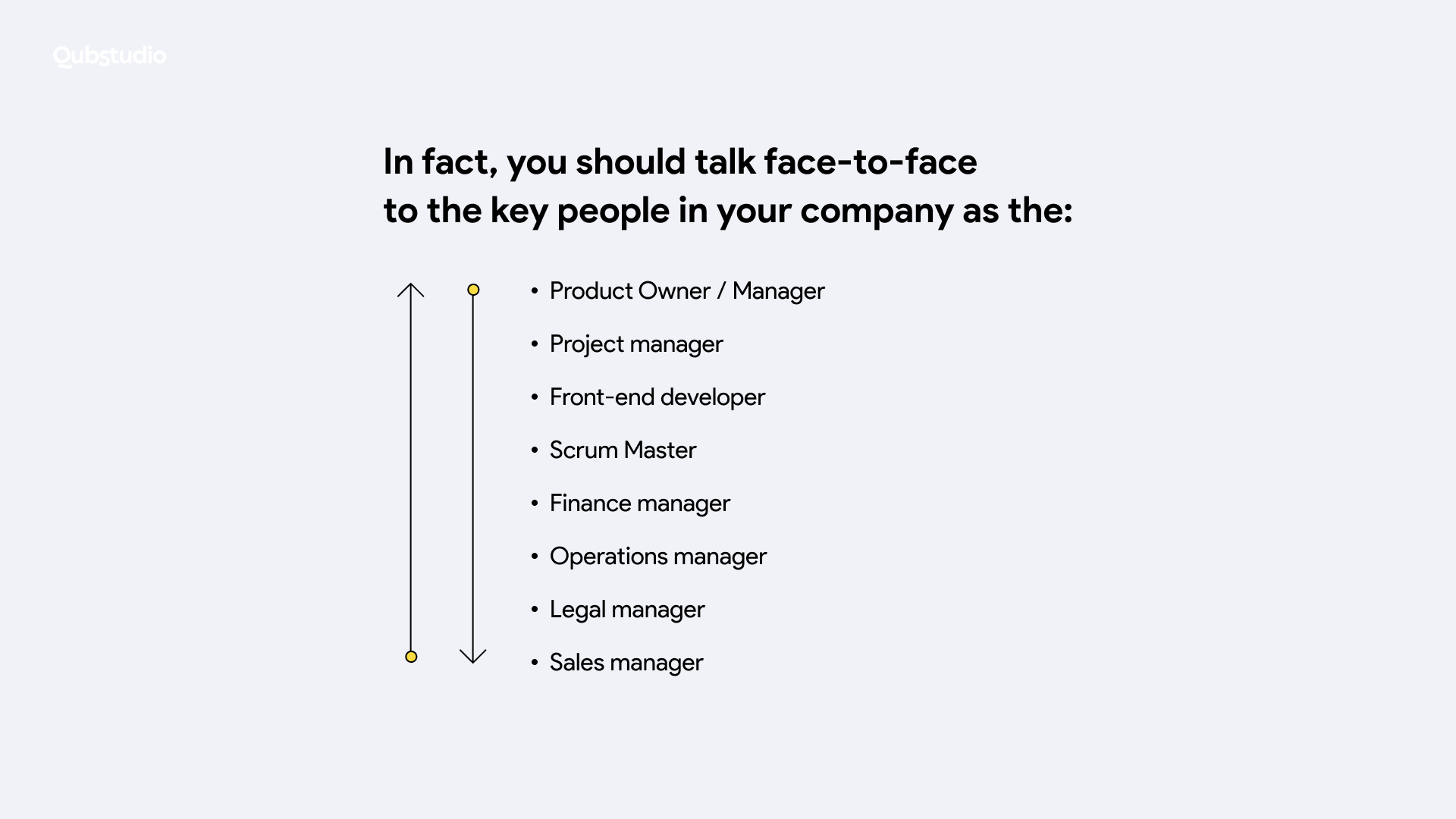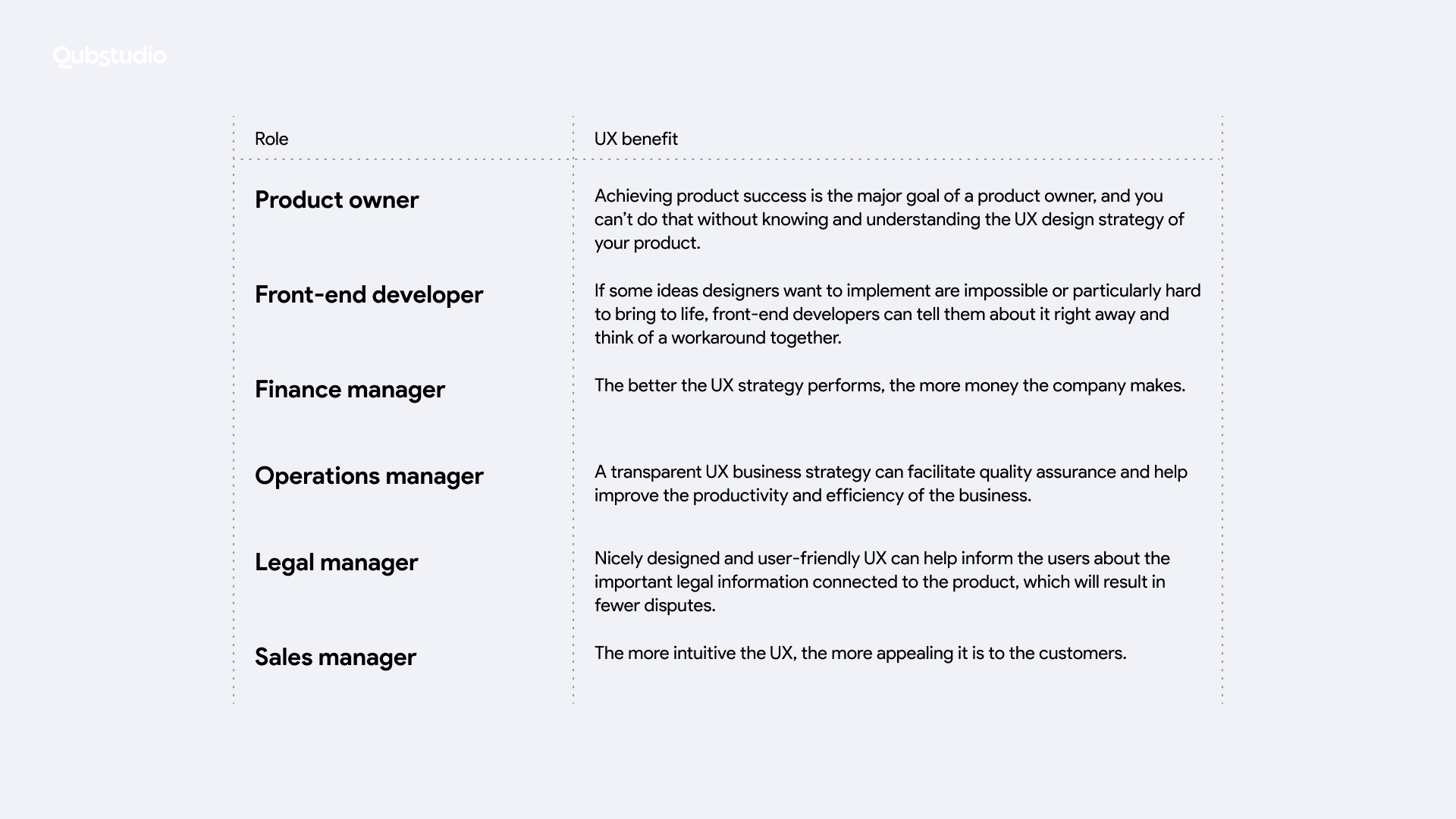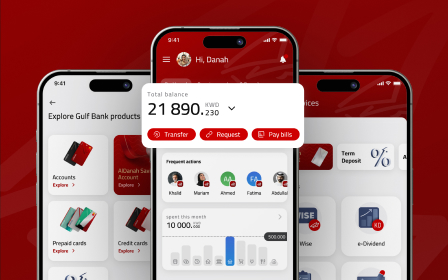How to Create and Communicate the UX Research Strategy to Your Team

- How to Create and Communicate the UX Research Strategy to Your Team
- What Is UX Research Strategy Plan and Its Types
- What are The Core Elements of UX Strategy?
- UX Research Methods and When to Use Them
- UX Research and Strategy: How to Create a Plan
- Importance of Understanding UX Strategy and UX Research
- UX Research Strategy & Product Success
- How to Communicate the User Experience Strategy to your Team?
- Final Thoughts
- FAQ
User Experience strategy helps systematize solutions essential for the company. And collaboration between teams is the key to creating a working and successful User Experience strategy.
How to Create and Communicate the UX Research Strategy to Your Team
While UX isn’t a new concept anymore, a lot of companies still find it pretty challenging to explain its importance. No doubt that the user experience teams know their value and how much they contribute to reaching the company’s business goals. But you can still hear other employees say things like “Those UX folks with their UX stuff” way too often. That’s because no one told them exactly how the company benefits from a successful UX research plan.
Remember: knowing your colleagues is as vital as knowing your customers, so take the time to communicate the importance of your UX research strategy plan to everyone in the company.
What Is UX Research Strategy Plan and Its Types
User Experience (UX) research strategy refers to the process of discovering and understanding the needs, behaviors, and preferences of users in order to design better products or services that meet their needs. A UX strategy plan helps businesses gain insights into their users’ experiences and expectations, and can guide the design of products that are intuitive, user-friendly, and enjoyable to use.
What are The Core Elements of UX Strategy?
The core elements include:
- User Interviews: This involves one-on-one conversations between researchers and users to gather insights into their behaviors, motivations, and pain points.
- Surveys: Surveys are a quantitative research method that can help businesses collect data on a large scale. They are used to gather information about user demographics, preferences, and behaviors.
- Usability Testing: This involves observing users as they interact with a product or service to identify any usability issues. It can be conducted in a lab or remotely, and can involve different types of tasks and scenarios.
- Card Sorting: This is a method used to understand how users categorize information. Participants are given a set of cards with items or topics, and are asked to group them in a way that makes sense to them.
- A/B Testing: This involves testing two or more variations of a design to determine which one performs better. It can be used to test different aspects of a product or service, such as layout, copy, or visual design.
UX Research Methods and When to Use Them
UX research methods are the different techniques used to gather data about users’ experiences and behaviors. These methods can vary depending on the research objectives, the target audience, and the resources available. Choosing the right research method is critical to ensuring that the data collected is relevant, reliable, and actionable.
To choose the right UX research method, it’s important to first define the research goals and questions. For example, if the goal is to understand how users interact with a new feature, usability testing may be the best method. On the other hand, if the goal is to gather information about user preferences and attitudes, user surveys or interviews may be more appropriate.
Some of the most commonly used UX research methods include user interviews, usability testing, surveys, card sorting, and focus groups. Each method has its strengths and weaknesses, and the choice of method should be based on the research objectives, the target audience, and the available resources.
The best UX research method ultimately depends on the research question and the specific context of the project. It’s important to carefully consider the research goals and available resources before choosing a research method. By selecting the most appropriate UX research method, businesses can gather valuable insights into their users’ needs and preferences, and create products that meet their expectations.
UX Research and Strategy: How to Create a Plan
The process of designing an effective product strategy User Experience strategy involves a step-by-step approach that can be followed by businesses of any size. So let’s go through the five critical steps in UX research and strategy that will enable you to deliver user-centric products and services.

1. Research Stage
The first stage in creating a successful UX strategy plan is to research your target audience. Research will help you understand the user’s needs, pain points, and preferences, which are vital in creating a user-centric experience. Start by conducting user interviews, surveys, and focus groups to gather data and insights that will guide your design decisions.
2. Outline Stage
Once you have gathered enough data and insights from the research stage, the next step is to create an outline of the UX strategy plan. The outline should include user personas, user journey maps, and design principles that will guide the creation of the user interface (UI). The user persona is a fictional representation of your target audience, which helps you understand the users’ goals, behaviors, and pain points. The user journey map outlines the steps that the user takes to accomplish a particular task, which helps you identify areas of improvement and optimization.
3. Testing Stage
The testing stage involves creating a prototype of the product or service to test with the users. The prototype should be based on the design principles and the user journey map. Testing helps you validate your assumptions, identify usability issues, and make design decisions based on user feedback.
4. Evaluation Stage
The evaluation stage involves analyzing the test results and making design decisions based on the insights gathered. It is essential in ensuring that the product or service meets the user’s needs and preferences. And also helps identify areas of improvement that will enhance the user experience.
5. Revision and Release Stage
The final stage involves revising the product or service based on the insights gathered from the evaluation stage and releasing it to the market. Revision stage is about making design decisions that will optimize the product’s usability and user satisfaction. And the release stage includes launching the product or service to the market and monitoring its performance to identify areas of improvement continually.
Importance of Understanding UX Strategy and UX Research
Creating a successful UX strategy plan requires a lot of effort, time, and dedication. However, just having such strategy is not enough. It’s equally important to ensure that your team, and other teams within your company, understand the importance of UX strategy plan and the value it brings to the table. This is where communication and collaboration come into play.

Ensure everyone in your company understands the effort, time, and dedication needed to create a quality user experience. By communicating the value of UX projects, you can gain approval and support from all employees. Collaboration is key to ensure your project evolves smoothly and succeeds. All teams should care about the UX strategy as much as the UX team. It’s important for stakeholders to participate in the UX development process to align business goals with the UX research and strategy. As a manager, use effective communication strategies to ensure everyone is on the same page.
UX Research Strategy & Product Success
A well-planned and executed UX strategy plan is essential for achieving product success, as it helps businesses gain insights into their users’ needs, behaviors, and preferences. In fact, according to a study by Forrester Research, companies that prioritize user experience see a 14.4% increase in their conversion rates, a 15.8% increase in customer satisfaction, and a 16.2% increase in revenue growth.
By conducting user research, businesses can create products or services that are tailored to their target audience, which can lead to increased customer satisfaction, loyalty, and ultimately, revenue. A survey by UserTesting found that 68% of users would be willing to pay more for a product or service that offers a better user experience.
Different UX research methods can also help businesses identify pain points in the user experience, which can then be addressed in the design process. According to a report by the Design Management Institute, design-driven companies outperform the S&P 500 by 219%.
Moreover, UX research strategy plan can help businesses stay ahead of the competition by identifying opportunities for innovation and differentiation. By gathering insights into users’ needs and behaviors, businesses can create products that stand out from the competition and provide a better user experience. A survey by McKinsey found that companies that prioritize innovation see a 5.4% increase in their operating income.
How to Communicate the User Experience Strategy to your Team
After you’ve applied the best UX research methodologies to produce a working UX strategy, communicate it to your UX team. If you’ve been failing to sell the UX strategy plan within your organization, we’ve got your back. Here are a couple of tips you can use to reach out to your employees.
Get people involved
Show your co-workers how every member of your team is connected to the UX development process. Personally communicating with your colleagues is always rewarding.

If you’re only used to pointing out pitfalls, you need to change this habit immediately. Ensure that the people mentioned above are well-aware of all the details of the User Experience strategy. Let them contribute and express some suggestions. This way, they’ll have a better understanding of how their responsibilities directly correlate with the UX.
First Things First
Let the designers conduct their research and think the UX design strategy through before the sprint starts. As Agile practitioners recommend, try to keep the User Experience team’s tasks ahead of time. This way, the UX team will have enough time to test out theories and get feedback from real users.
Usability Testing
User research might take some time, but by no means should it be monotonous. Get everyone to participate in this process, let them observe and debate. Seeing the data results with your own eyes always gives you a better picture of how the UX is working, and if it’s working at all. For instance, you can try to make usability testing a part of the team building events.
UX Role by Role
If you want every member of your team to know how helpful and profitable UX is, show them real examples of UX influence. First, start with the managers in your company. Tell them how UX affects their work and how they can benefit from it.

As you can see, various departments are connected to the UX developing process one way or another. So, don’t hide this critical information from them. Make presentations, hold workshops, team building exercises, sing or dance if needed.
Transparency
Don’t expect everyone’s engagement if you hide the entire process from them. Be as clear as possible, share all the details of the UX strategy plan. What’s more, be open to feedback. Weekly or daily updates from the UX team might be enough to keep your teams on track and caught up on the news.
The same applies to business goals. Keep all the documentation open and accessible.
There’s No Limit to Perfection
Don’t be afraid to fail. There’s nothing wrong with trying out various UX communication techniques. Failures can help you find the most efficient way to communicate your UX research and strategy to your employees. Experiment, change tactics and customize them according to the environment in your company. If you only focus on making your strategy perfect, you might forget about making it effective. You know what startups say: fail fast.
A Dynamic Approach
Creative minds have to be involved in a dynamic working process. Otherwise, they’ll simply get bored. Don’t let that happen. Get the key members of your teams to participate in the UX strategic meetings and share their ideas. Communication between teams will help you spot the drawbacks of the UX strategies, and, as a result, improve it during the early stages.
Sharing Updates
If certain people can’t attend strategic meetings, don’t forget to share all the latest updates with them. It’s a good idea to have a joint group in whatever corporate messaging system you’re using and post all the valuable information there.
Also, keep the stakeholders aware of what’s going on. Give everyone a chance to communicate and exchange opinions. Even short texts about updates can be of tremendous value in big companies with distributed teams.
Final Thoughts
When creating and communicating a UX research plan to your team, it is essential to start with a clear understanding of your target audience, their needs, and pain points. This information should serve as the foundation for informing the design process. Involving various teams in the process can also be highly beneficial in ensuring that everyone has a shared understanding of the project goals and user needs.
When communicating this strategy to your team, it is crucial to emphasize the importance of collaboration and the iterative nature of UX design. Feedback is an integral part of this process and should be encouraged from employees and stakeholders alike. To facilitate this feedback loop, regular meetings and a joint messenger group can be a great starting point.
It’s important to remember that perfect synergy can only be achieved through rounds of failures and modifications. Embracing this process and continually refining your strategy will enable you to deliver digital products that meet user needs and exceed expectations. At Qubstudio, we understand the importance of creating and communicating a UX strategy that sets the team up for success, and we employ these best practices to deliver exceptional design solutions.
FAQ
How do you create an UX strategy?
To create a UX research strategy, you should start by defining the problem you want to solve, identifying your target audience, and selecting the appropriate UX research methods based on your research questions and goals. The steps in UX research typically include planning and preparation, data collection, analysis, and reporting. It’s important to involve stakeholders, including designers, developers, and product managers, throughout the process to ensure the research is aligned with business objectives.
What are the 5 levels of UX strategy?
The 5 levels of UX strategy, according to Jared Spool, are: foundation, framing, surface, deep structures, and culture. The foundation level involves understanding the business objectives and user needs, while the framing level includes defining the problem and establishing design principles. The surface level focuses on the visual and interactive aspects of the product, while the deep structures level deals with the underlying information architecture and navigation. The culture level involves embedding UX into the organization’s culture and processes.
What are the three elements for a UX strategy?
The three elements of a UX strategy are: business strategy, user needs, and design principles. The business strategy outlines the goals and objectives of the organization, while user needs represent the behaviors and preferences of the target audience. Design principles provide guidance for creating a user-centered design that meets both business and user goals.
What is a typical UX research plan?
A typical UX research plan includes defining research questions, selecting appropriate UX research methods, recruiting participants, conducting research, analyzing data, and reporting findings. UX researchers may use a variety of UX research methods and techniques, such as interviews, surveys, usability testing, and ethnographic observation, depending on the research questions and goals.
What does a UX researcher do?
A UX researcher is responsible for conducting user research to gain insights into users’ needs, behaviors, and preferences. This involves planning and executing UX research methods, analyzing data, and communicating findings to stakeholders. UX researchers collaborate with designers, developers, and product managers to ensure the design of a product or service is user-centered and meets both business and user goals.
What is the difference between user research and UX research strategy plan?
User research and User Experience research are related but distinct fields. User research typically focuses on understanding user needs, behaviors, and preferences, while UX research encompasses a broader range of activities, including user research, usability testing, and user experience evaluation. User research is a subset of User Experience research and is typically conducted at the beginning of the design process to inform design decisions. UX research may be conducted throughout the design process to evaluate and improve the user experience.




